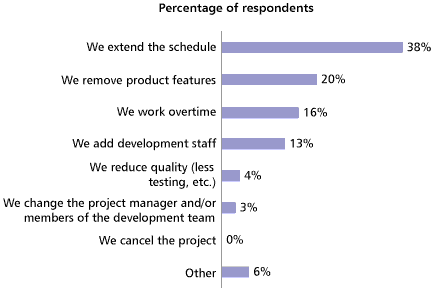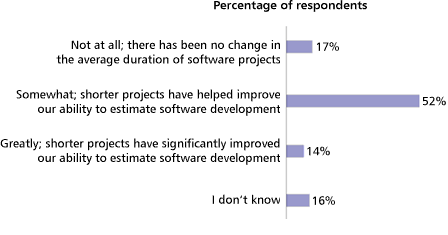In 2002, the most common remedy for schedule problems was overtime. Now, six years later, a Cutter Consortium survey has revealed some interesting news: when projects run into scheduling problems, the two most common remedies are extending the schedule and reducing functionality, with overtime relegated to third place, followed by adding staff. This represents a distinct change from 2002, when Cutter conducted an identical survey. Cutter Consortium Senior Consultant E.M. Bennatan spearheaded both surveys.
"Previously we found overtime to be the most common response to project underestimation, followed by schedule extension, adding development staff, removal of product features, and the reduction of quality - indicated by less testing, for example. When we reran this survey in late 2008, we discovered that schedule extension and feature removal have been elevated to the top of the list. [See Figure 1] This indicates broader acceptance of project estimation conclusions, particularly during (rather than before) development. To a large degree, the shift away from adding overtime indicates a positive change in culture. Organizational behavior is improving!"

Figure 1 -- Which are most common ways to resolve problems linked to an underestimated schedule?
This raises questions about the poor estimations produced earlier in the project. Why would later estimations - the estimates that actually result in a change in behavior -- be considered better than earlier ones? Bennatan explains, "The answer is in the extent of the work that is estimated. There is more information available to estimators at the review, and the amount of work that remains is significantly less than at the start of the project. Therefore, the new estimates carry more credence. As large development projects progress, our ability to estimate them improves. So when, in the last third of a project schedule, the estimates indicate that the schedule cannot be achieved, it is usually wise to either remove functionality (less work) or extend the schedule."
Previous Cutter Consortium research1 has consistently shown the move toward more manageable agile software projects (short, evolutionary, customer-driven). Bennatan examined this phenomenon for this survey and found a clear preference toward smaller projects and the estimation advantages they provide. (See Figure 2.)

Figure 2 -- Have shorter software projects affected your organization's ability to estimate software development?
"Just 17% of companies responded that the average duration of projects had not changed [23% in 2002]", remarked Bennatan, "Of the rest, 66% had experienced improvements in their estimation success rate due to shorter projects [63% in 2002]." This includes 14% who said they improved "greatly" [18% in 2002], meaning that shorter projects have produced significantly better estimates. The remaining 16% did not know whether shorter projects had affected their organization.
To request a copy of the Agile Product & Project Management Executive Update (Vol. 9, No. 20), containing E.M. Bennatan's analysis, or to schedule an interview with Mr. Bennatan, contact Kim Leonard (+1 781 641 5111 or kleonard@cutter.com).
About Cutter Consortium
Note
1Bennatan, E.M., "Software Project Planning: Part III -- Divide and Conquer," Cutter Consortium Agile Product & Project Management Executive Update, Vol. 9, No. 14


